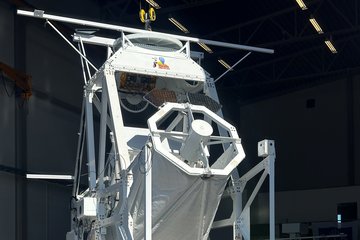All genres
21.
Journal Article
The ion-acoustic soliton: A gas-dynamic viewpoint. Physics of Plasmas 9 (3), pp. 800 - 805 (2002)
22.
Journal Article
The fluid-dynamic paradigm of the dust-acoustic soliton. Journal of Plasma Physics 67 (5), pp. 353 - 362 (2002)
23.
Journal Article
The properties of fast and slow oblique solitons in a magnetized plasma. Physics of Plasmas 9 (1), pp. 55 - 63 (2002)
24.
Journal Article
The structure of solitons propagating obliquely to the magnetic field. Physica Scripta T98 (17), pp. 146 - 150 (2002)
25.
Journal Article
Coherent waves in multi-ion plasmas. Physica Scripta T98, pp. 52 - 57 (2002)
26.
Journal Article
Wave emissions by whistler oscillitons. Application to coherent lion roars. Geophysical Research Letters 29 (24), 2226 (2002)
27.
Journal Article
Compressive instability driven by ion-cyclotron dissipation in the solar wind. Solar Physics 200, pp. 251 - 258 (2001)
28.
Journal Article
Stationary structures in multi-ion plasmas with differential streaming. Journal of Plasma Physics 65 (3), pp. 181 - 195 (2001)
29.
Journal Article
Oblique solitons in a cold magnetized plasma. Physics of Plasmas 8 (10), pp. 4367 - 4374 (2001)
30.
Journal Article
Nonlinear waves propagating transverse to the magnetic field. Journal of Plasma Physics 65, pp. 213 - 233 (2001)
31.
Journal Article
Stationary waves in a bi-ion plasma transverse to the magnetic field. Journal of Plasma Physics 65, pp. 197 - 212 (2001)
32.
Journal Article
New type of soliton in bi-ion plasmas and possible implications. Geophysical Research Letters 28, pp. 3589 - 3592 (2001)
33.
Journal Article
Hydromagnetic gravity waves in the solar atmosphere. Astrophysical Journal 537 (1 (Part 1)), pp. 516 - 523 (2000)
34.
Journal Article
Can gravitational effects damp Alfvén waves? Solar Physics 193, pp. 153 - 159 (2000)
35.
Journal Article
Acceleration of the high speed solar wind in coronal holes. Space Science Reviews 87, pp. 25 - 41 (1999)
36.
Journal Article
The temperature and density structure in the closed field regions of the solar corona. Astronomy and Astrophysics 350, pp. 1035 - 1039 (1999)
37.
Journal Article
Solar coronal heating by high-frequency dispersive Alfvén waves. Solar Physics 186, pp. 61 - 66 (1999)
38.
Journal Article
Stationary incompressible MHD perturbations generated by a current source in a moving plasma. Planetary and Space Science 47, pp. 545 - 555 (1999)
39.
Journal Article
An analytic solar magnetic field model. Astronomy and Astrophysics 337, pp. 940 - 944 (1998)
40.
Journal Article
Heating and acceleration of minor ions in the solar wind. Astronomy and Astrophysics 335, pp. 303 - 308 (1998)











